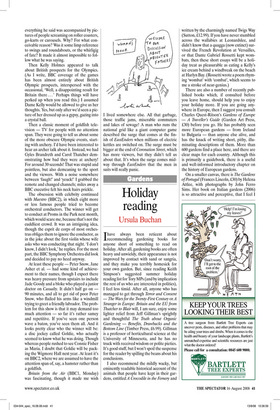Gardens
Holiday reading
Ursula Buchan
Ihave always been reticent about recommending gardening books for anyone short of something to read on holiday. After all, gardening books are often heavy and unwieldy, their appearance is not improved by contact with sand or sangria, and they make you terribly homesick for your own garden. But, since reading Keith Simpson’s suggested summer holiday reading list for Tory MPs (and by implication the rest of us who are interested in politics), I feel less timid. After all, anyone who has managed to get through Terror and Consent — The Wars for the Twenty-First Century or A Stranger in Europe: Britain and the EU from Thatcher to Blair will, I am sure, enjoy some lighter relief from Jeff Gillman’s sprightly and thoughtful The Truth about Organic Gardening — Benefits, Drawbacks and the Bottom Line (Timber Press, £6.99). Gillman is a professor of horticultural science at the University of Minnesota, and he has no truck with received wisdom or polite pieties. It’s good stuff, but I won’t spoil the suspense for the reader by spilling the beans about his conclusions.
I also recommend the mildly wacky, but eminently readable historical account of the animals that people have kept in their gardens, entitled A Crocodile in the Fernery and written by the charmingly named Twigs Way (Sutton, £12.99). If you have never stumbled across the wallabies at Leonardslee, and didn’t know that a quagga (now extinct) survived the French Revolution at Versailles, or that Dante Gabriel Rossetti kept wombats, then these short essays will be a holiday treat as pleasurable as eating a Kelly’s ice cream behind a windbreak on the beach at Harlyn Bay. (Rossetti wrote a poem rhyming ‘wombat’ with ‘combat’, which seems to me a stroke of near-genius.) There are also a number of recently published books which, if consulted before you leave home, should help you to enjoy your holiday more. If you are going anywhere in Europe, then I suggest you consult Charles Quest-Ritson’s Gardens of Europe — A Traveller’s Guide (Garden Art Press, £30) before you go. He has probably seen more European gardens — from Ireland to Bulgaria — than anyone else alive, and has the knack of writing short, pithy, illuminating descriptions of them. More than 600 gardens find a place here, and there are clear maps for each country. Although this is primarily a guidebook, there is a useful and well-informed introductory chapter on the history of European gardens.
On a smaller canvas, there is The Gardens of Portugal (Frances Lincoln, £30) by Helena Attlee, with photographs by John Ferro Sims. Her book on Italian gardens (2006) is so attractive and perceptive, that I feel I can also take her word for the charms and interest of Portuguese gardens, with their distinctive polychrome azulejos tiles, camellia topiary, citrus orchards, granite statues, canalised water and lush sub-tropical plantings. Portugal has an Atlantic climate, which means that, although summer temperatures are very hot, there is plenty of rain, a great benefit to southern European gardens. The country also has a complex political history, which has ensured influences from France, Italy, England and North Africa. What is plain from this book is that historic Portuguese gardens are not always wellmaintained but that anyone who bothers to seek them out will find them refreshingly free of other visitors (the two facts being, of course, connected).
The book, above all, that you should find space for in the suitcase is Helen Dillon’s Garden Book (Frances Lincoln, £25). This is a volume of musings on anything and everything, from garden centres to gardening in old age, from vanishing tools to mobile plants. It is divided into three sections: Beginners’ Stuff, The Middle Ground and Fancy Stuff. Anyone who can begin a book ‘Shouldn’t have’ is likely to win over the reader from the start.
Helen Dillon has a wonderful (open to the public) garden in the smart suburb of Ranelagh in Dublin, and is hugely admired by keen gardeners for her energy and expertise as lecturer, broadcaster and author. She is a really good practical gardener who puts plants together beautifully. Moreover, she is witty, knowledgeable, doesn’t give a damn and rarely writes a dull sentence. Here she is on the subject of pot-bound plants, for example: ‘I see no point in planting a constipated wodge of roots.’ On propagation, she writes: ‘If a plant could read my thoughts, it might feel very edgy indeed,’ and on delphiniums, just coming into flower: ‘At this moment along comes the Delphinium Wind. We hear it moaning away in the middle of the night and in the morning we can hardly bear to look out of the window.’ There are some excellent, sometimes quite earthy, jokes but the greatest virtue of this book is that everything in it comes from hard-won personal experience. If you read this book on holiday, it won’t be homesickness that will dog you, but the desire to swing past Dublin on the way home.



























































 Previous page
Previous page